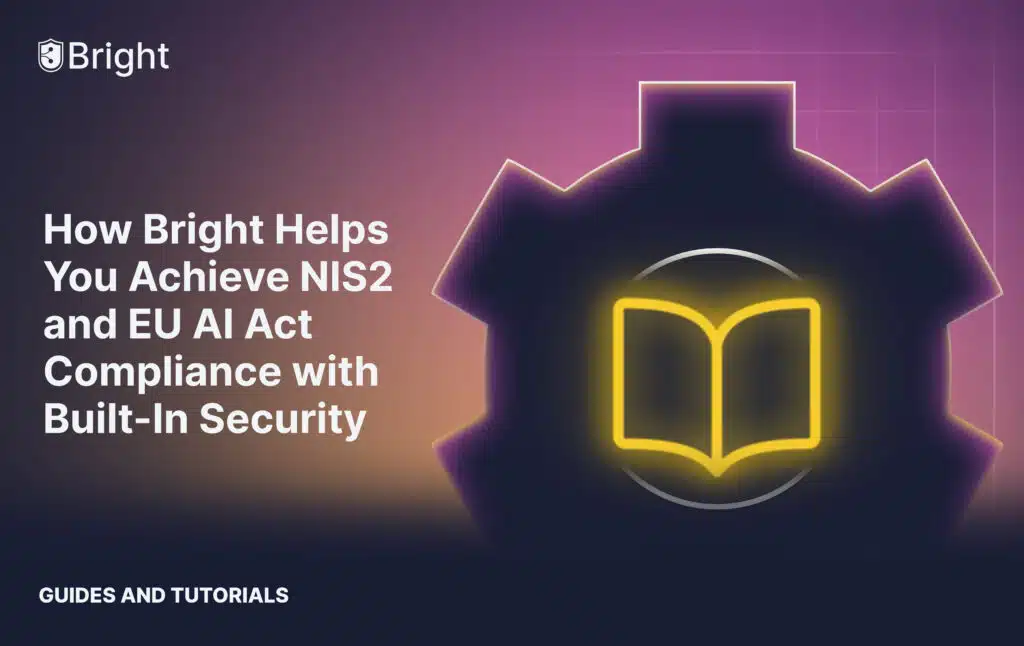At Bright, we don’t just build application security tools – we live security. As Bright’s CISO, I understand the weight of regulatory frameworks like the NIS2 Directive and the EU AI Act, because we operate under the same scrutiny and expectations we help our customers address. We built Bright to help security leaders and AppSec teams integrate compliance naturally into their workflows, not bolt it on as an afterthought.
Regulatory change in the EU is coming fast, and it’s reshaping how organizations think about risk. NIS2 significantly broadens the definition of “essential entities,” placing critical focus on continuous risk monitoring, rapid incident reporting, and supplier oversight. The EU AI Act goes a step further into uncharted territory – requiring provable technical robustness, secure data handling, and the ability to monitor AI systems long after deployment. These frameworks aren’t just legal hurdles; they reflect a shift toward real operational accountability. And while the stakes are high, they also present a clear opportunity to align better security with smarter compliance.
Meeting NIS2 Requirements with Bright DAST
Let’s start with NIS2. It’s no longer enough to scan your apps once a year and call it risk management. The directive expects ongoing identification and remediation of vulnerabilities across your systems. Bright DAST enables continuous scanning of your web applications and APIs, including authenticated and logic-based testing that covers the OWASP Top 10 and beyond. Our platform doesn’t just flag issues; it correlates them to risk severity, suggests fix paths, and integrates directly into your CI/CD pipeline, issue trackers like Jira, and collaboration tools like Slack. This enables organizations to enforce security checks on every build or push, making vulnerability remediation part of the development cycle – not a post-deployment surprise.
Audit Readiness Built Into the Process
Audit readiness is baked into the process. Every scan run in Bright is logged, every issue is tracked with metadata, and every fix is verified. When regulators or auditors ask how you’ve fulfilled the directive’s Article 21 requirements, Bright gives you a defensible audit trail showing exactly how vulnerabilities were identified, triaged, and resolved. No more scrambling to stitch together reports from disconnected tools.
Rapid Incident Response for the 72-Hour Mandate
Incident response timelines—especially the 72-hour reporting mandate in NIS2—require fast, reliable detection. Bright integrates with SIEM platforms and supports webhook and API-based automation so your existing detection and response infrastructure can respond immediately to scan results. Because our scan data includes contextual metadata—like attack surface characteristics—it reduces ambiguity when compiling regulatory disclosures. You’re not just compliant; you’re ready with the right information, in the right format, when time is tight.
Securing the Supply Chain
Supply chain security, one of NIS2’s most challenging mandates, is a native part of our workflow. Bright supports SBOM-style visibility through detailed scans of open-source dependencies, third-party integrations, and microservice components – highlighting known vulnerabilities or unsafe configurations. And if you or your vendor runs Bright, authorized scans of internal and external ecosystems provide rich reports detailing what’s wrong and how to fix it. Our scan reports include remediation guidance and exploit evidence to accelerate prioritization. These insights support vendor risk assessments and due diligence without the guesswork or overhead of traditional questionnaires, helping ensure you’re not inheriting someone else’s risk.
Addressing EU AI Act Requirements
The AI Act introduces a new level of scrutiny for how AI systems are secured – and Bright is one of the few DAST platforms that meets it head-on. We’ve built capabilities that specifically target threats to AI models and interfaces, including prompt injection, and insecure output handling. Our attack simulation engine can be used against LLM endpoints, REST and GraphQL APIs, and other AI-exposed interfaces to identify vulnerabilities that could affect decision logic, user trust, or downstream compliance. Combined with role-based authentication testing and output validation, Bright enables you to test AI behavior not just for functionality, but for safety and resilience.
Standards-Based Compliance for AI Security
Our work aligns with the OWASP Top 10 for LLMs and ENISA’s AI cybersecurity guidelines – giving you a standards-based foundation for compliance. With Bright, organizations can simulate real-world adversarial scenarios and document how their AI systems handle them. That supports Articles 9 and 15 of the AI Act, which require that risk mitigation and technical robustness are proven – not assumed. And our platform supports continuous validation post-deployment, helping you catch performance drift or degraded security before it turns into regulatory trouble.
Removing the Ambiguity from Compliance
What we hear from CISOs, time and again, is that the laws themselves aren’t the hard part – it’s the ambiguity of how to satisfy them. Bright DAST was built to remove that ambiguity. We translate regulatory mandates into daily security activity. We don’t ask you to slow down or bolt on compliance – we let you embed it directly into how your security program already works.
More Than the Minimum: Raising the Bar
And that’s the bottom line. At Bright, our goal isn’t to give you more dashboards or another pile of alerts. Our job is to help you move faster, stay ahead of threats, and walk into every audit knowing you’ve done more than the minimum – you’ve built something secure, resilient, and compliant by design. Whether you’re preparing for NIS2, the AI Act, or both, Bright DAST is here not just to help you meet the bar – but to raise it.





